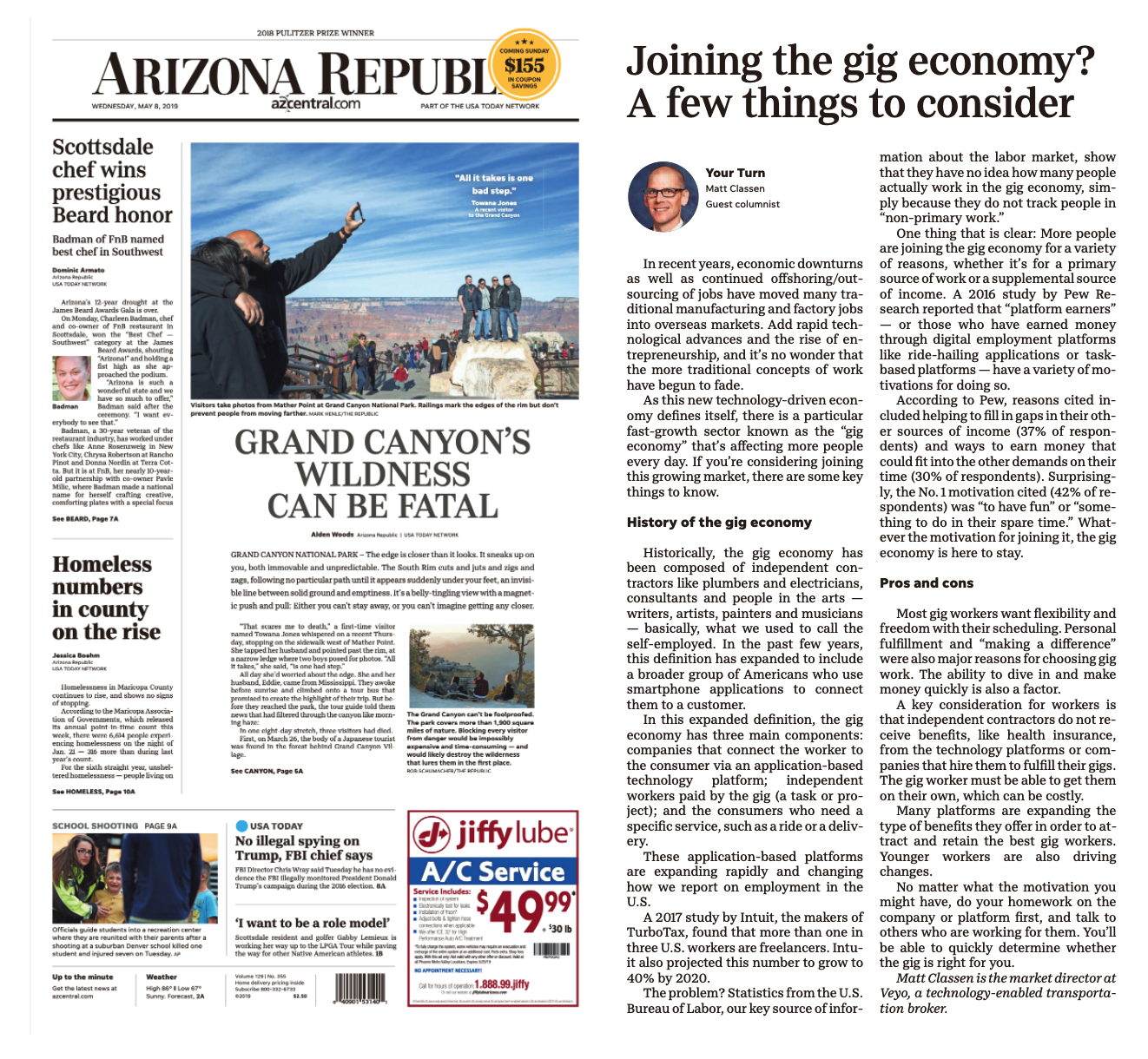Veyo highlighted in the Arizona Republic
May 8, 2019
Veyo was recently featured in the Arizona Republic with an article by our Arizona and California Market Director, Matt Classen. The article was titled “Joining the gig economy? A few things to consider” and has been replicated below:
——-
Joining the Gig Economy: Key Points About Ride Sharing & Independent Contracting
By Matt Classen
In recent years, economic downturns, as well as continued offshoring/outsourcing of jobs, have moved many traditional manufacturing and factory jobs into overseas markets. Add in rapid technological advances and the rise of entrepreneurship, and it’s no wonder that the more traditional concepts of work and careers have begun to fade. As this new technology-driven economy defines itself, there is a particular fast-growth sector known as the ‘gig economy’ that’s affecting more people every day. If you’re considering joining this growing market, there are some key things to know.
The History of the Gig Economy
Historically, the gig economy has been comprised of independent contractors like plumbers and electricians, consultants, and people in the arts – writers, artists, painters, and musicians – basically, what we used to call the self-employed. In the last few years, this definition has expanded to include a broader group of Americans who use smartphone applications to connect them to a customer.
In this expanded definition, the gig economy has three main components: companies that connect the worker to the consumer via an application-based technology platform; independent workers paid by the gig (a task or project); and the consumers who need a specific service, such as a ride or a delivery.
These application-based platforms are expanding rapidly and changing how we report on employment in the US. A 2017 study by Intuit, the makers of TurboTax, showed that more than one in three U.S. workers are freelancers. Intuit also projected this number to grow to 40% by 2020. The problem? Statistics from the U.S. Bureau of Labor (USBL) – our key source of information about the labor market – show that they have no idea how many people actually work in the gig economy, simply because they do not track people in ‘non-primary work’. USBL’s definition of a gig worker spans everything from babysitters to Uber drivers, and this loose definition includes up to 75 million people in the workforce.
One thing that is clear: more people are joining the gig economy for a variety of reasons, whether it’s for a primary source of work or a supplemental source of income. A 2016 study by Pew Research showed that ‘platform earners’ – or those who have earned money through digital employment platforms like ride-hailing applications or task-based platforms – have a variety of motivations for doing so.
According to Pew, reasons cited included helping to fill in gaps in their other sources of income (37% of respondents) and ways to earn money that could fit into the other demands on their time (30% of respondents). Surprisingly, the number one motivation cited (42% of respondents) was ‘to have fun’ or ‘something to do in their spare time.’ Whatever the motivation for joining it, the gig economy is here to stay.
The Pros and Cons of Independent Contracting
Independent contractors – whether they’re knowledge-based, like business consultants, or service-based – like tradespeople, creative services, and ride-share or delivery drivers – have some distinct advantages and disadvantages to consider.
Most independent contractors or gig workers choose to enter the gig economy for the flexibility and freedom that it provides them with their scheduling. Personal fulfillment and ‘making a difference’ were also major reasons for choosing gig work. The ability to dive in and make money quickly is also a factor.
A key consideration for workers is that independent contractors do not receive benefits, like health insurance, from the technology platforms or companies that hire them to fulfill their gigs. The gig worker must be able to get them on their own, which can be costly.
Many platforms are expanding the type of benefits they offer in order to attract and retain the best gig workers. Younger workers are also driving changes. As digital natives, they’re serial multi-taskers who tend to get bored easily. Many prefer the stability of an anchor employer combined with the flexibility of different jobs or gigs, to earn more money while staying true to their restless nature.
No matter what the motivation you might have, do your homework on the company or platform first, and talk to others who are working for them. You’ll be able to quickly determine whether the gig is right for you.


